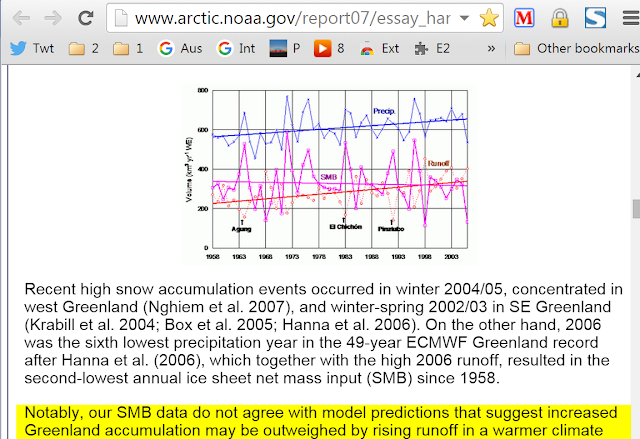There's a New York Times graphic with a dodgy caption claiming that the ice is moving faster than can be replaced by falling snow.
This is impossible; it can only be more snow that speeds up the glacier, or changes in geothermal heat under the glacier, it can't be air temperature or global warming.
Ice is a good insulator of heat. A few degrees air temperature rise can not lubricate a glacier or make it flow faster.
Professor Cliff Ollier explains here:
http://www.lavoisier.com.au/articles/greenhouse-science/glaciation-icecaps/ollierglaciersnov2007.pdf
Video:
This graph shows the more likely cause of the glacier speed up, more snow:
Precipitation actually increased the last few years, which should speed the glacier up. Supposedly the melting or "runoff" has increased in that time. That's odd to blame that on global warming when there hasn't been really any warming for 18 years.
Black soot's a more likely cause for increased melt, in which case it's nothing to do with global warming™.
The GRACE satellite data is often used to claim Greenland's melting down.
That satellite data that uses gravity to measure ice sheets are adjusted by Glacial Isostatic Adjustment. No one really knows what the magnitude of this adjustment should be so they just guess. And surprise, surprise the adjustment just so happens to bolster the AGW melt story.
Something doesn't look right about the following graph from SkS. It shows a bizarre mass drop-off after the year 2000.
Even if true there's really no relation between the sudden loss of ice mass on Greenland and the steady rise of CO2. Why did mass gain until the year 2000 when CO2's been rising since the 1950's?
Global average air temperature (whatever that means) peaked in 1998 with a modest 0.6C rise since about 1976. How does that suddenly produce dramatic ice loss like this? It's wishful thinking.
They recently had to scale back the level of their dubious GRACE tweaking highlighting that they don't know what they're doing:
GRACE’s warts – new peer-reviewed paper suggests errors and adjustments may be large
Furthermore it snows more at both poles when it warms a bit, which is why they don't or can't melt during this warmer Holocene.
In Antarctica:
http://www.sciencenewsline.com/news/2015031616500055.html?utm_content=bufferb5c3d&utm_medium=social&utm_source=twitter.com&utm_campaign=buffer
Antarctic Ice Sheet is Growing http://t.co/z5MVeAbpEc Mr Ed, the Antarctic is growing as shown here, along with glaciers around the world
— Dave Rowe (@dgrwhippet) July 6, 2015http://www.uu.nl/en/news/global-warming-brings-more-snowfall-to-antarctica-causing-reduction-in-sea-level
..and in Greenland; more snow accumulation with higher air temperature:
If Greenland truly was melting down you'd think there would be at least some noticeable increase to sea level rise but there isn't:
Many elements of this government funded climate scare story don't add up.







No comments:
Post a Comment